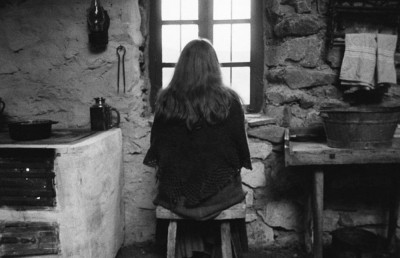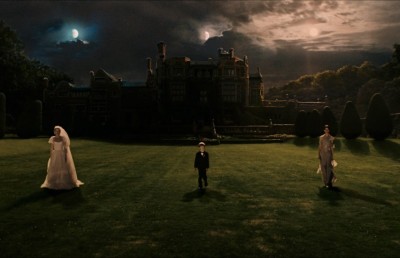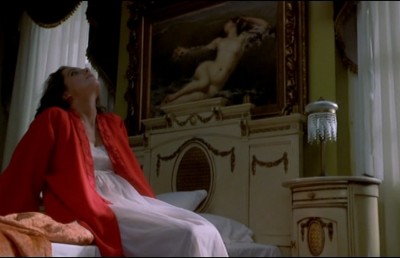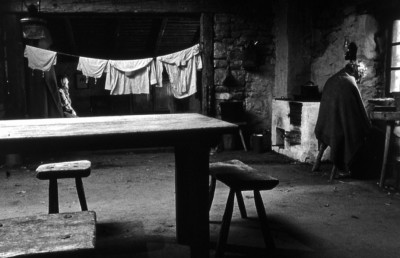Nature and Grace, Image and Thought: Terrence Malick’s The Tree of Life
Consciousness is Enriched by an Original Perception of the Living World
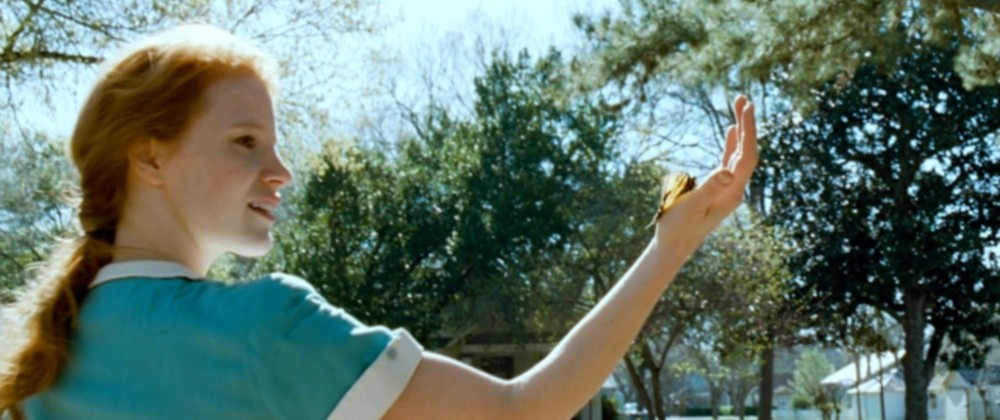
The Tree of Life
Directed by Terrence Malick
Editors: Mark Yoshikawa, and Hank Corwin,
Jay Rabinowitz, Daniel Rezende, and Billy Weber
Twentieth Century Fox, 2011
Image and thought are both important in the work of film writer and director Terrence Malick, and that makes his work a special pleasure for the thinking film viewer. Films such as Days of Heaven and The New World have made him a marvel in the film world. To praise his work for its beauty, eccentricity, innovation, natural landscapes, and spiritual speculations can seem both reflexive and unnecessary: it is like praising sunlight or rain. Terrence Malick’s The Tree of Life, winner of the Palme D’Or at the 2011 Cannes film festival, is likely to be one of his most important and best-loved films: focused on an American southern family headed by a strict but loving father and an accepting, loving, but more passive mother, the film has a biographical specificity and situational accessibility that could make it initially attractive to almost anyone; and yet the film is an investigation of the ways of nature and grace, of divergent ways of being in the world, and of the human relationship to the existence of the divine, and those concerns make The Tree of Life a demanding and rewarding work. Watching it more than once, more than twice, thrice, does not exhaust its appeal. It is a film that contains mysteries—and questions and answers. The images, beautiful in themselves, revealing for how they show the love and tensions in a family, are partnered with a narrated consciousness—mostly of mother and elder son—that make clear the meaning that is attached to appearances, to articulations, and to acts. The acts shape mood, become memory, and influence individual character and the satisfaction that a person is likely to gain from life. The film, dramatic and philosophical, has two virtuosic demonstrations of imagination: one is the imagination of the origin of the world; and the other is a view of life after death, of a human heaven; and each is the kind of thing that is likely to inspire one viewer or another to declare “Malick is a genius” or “he is mad.” How many films or their makers still garner that kind of genuine response?
The film The Tree of Life, written and directed by Malick, has more than one opening and more than one close, which is to say it is a work of patterns, organized around spiritual belief, the facts of the universe, a mother’s love, a father’s demands, and grief. When the motion picture begins, there is a quote from the book of Job about the origins of the earth; and the viewer is shown a shaft of gold light in the darkness; and a little girl looks out of the window of a farm door; and we hear comments about nature and grace—we are told that grace accepts and is not selfish, but that nature is self-centered and willful, and we see images of the mother as we hear of grace and we see images of the father as we hear of nature. Near the end of the film, after his ambition has been rebuked, the father admits that he lived and “didn’t notice the glory. A foolish man.” The older son Jack thinks, “Father. Mother. Always you wrestle inside me.” The son is struggling with both nature and grace; and as a boy he told his father, “I’m just as bad as you. I’m more like you than her.” We see again near the film’s end an image of the young farm girl, presumably the mother; and then we see the mother with her husband and children, her family, its members glimpsed at different stages of life, in heaven. The middle of the film is where much of the love and wrestling take place, and, as at the beginning of The Tree of Life, there is amid the life and love and work of the father, mother, children, and their community, a reference to Job, specifically a church sermon on the life of Job, on the mercurial divine punishment of a good man.
Terrence Malick’s The Tree of Life stars Jessica Chastain as the mother and Brad Pitt as the father; and, of course, both give very good performances. Chastain’s performance is that of a woman who has been scrubbed of any falsity; and she seems in the moment, exuding awareness, love, sadness, perplexity, playfulness, a woman whose existence is both fragile and independent. Brad Pitt’s performance is more worldly; he is a man of confidence and determination living among his family and contending with other men, and his facial expressions and posture suggest his southern place and the passage of time. He loves his family (he has a surprising but charming habit of asking his sons to kiss him), but he has a very particular, even rigid, sense of the way the world works, that it is not a fair place, and he wants to be a winner in that world. The three young sons, Jack, R.L., and Steve, are still developing but their personalities are perceptible, with the older son, Jack, being tough, watchful, judgmental, listening to what his parents say but also judging what they do; and the middle son, R.L., is sensitive, possibly a budding artist, someone who does not want to fight and who plays guitar well and paints pictures; and the youngest son, Steve, is quiet, fun-loving, not yet having discovered his special concerns. The brothers are played by Hunter McCracken (Jack), Laramie Eppler (R.L.), and Tye Sheridan (Steve); and it is impossible, now, to imagine other actors in their roles. These are all attractive people, and their relationship to each other seems true, in terms of what they know and do not know about each other.
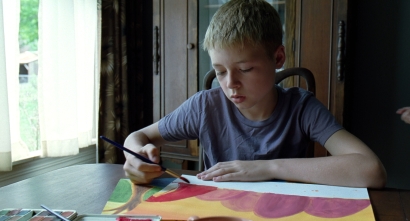
R.L. the artistic son
The second brother, R.L., like the mother, seems a figure of grace; and he dies young, at age nineteen. One of the first things we learn in the film is the fact of his death, with the mother receiving a telegram at home and the father receiving a telephone call at an airport, where he is doing some work. The older brother, Jack, a man, some kind of builder, seems to be remembering the day of his brother’s death, years later. He and his father talk over the phone, reconciling after some disagreement in which Jack said something questionable to his father about the lost brother. The motion picture takes us back to the time of that death, when the parents are in the midst of grief in a leafy, comfortable, but somewhat ordinary Texas neighborhood, attended by friends and family. The dead boy is in his god’s hands, someone says: but the mother’s statement is, “He was in god’s hands the whole time—wasn’t he?” Is such a god real; and does he care about human existence? The deceased boy’s grandmother, soon after his passing, tells his mother that god gives and takes and “sends flies to wound that he should heal.” The father regrets sharing shame, his shame, with his son; and that shame possibly was due to the father’s business failure, despite having many patents for his work, and shame for the father’s not pursuing his own love of classical music as a profession. (The film’s score, by Alexandre Desplat, is stuffed to bursting with classical music.)
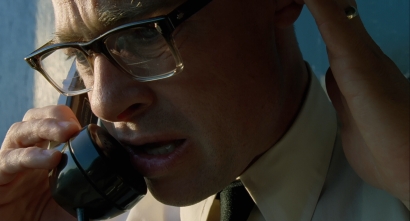
The father (Pitt) receiving the news
The film viewer sees the fast movement of images, blurry colors, travel through a city; and a door in the wilderness, a desert. It could be the door to heaven (or purgatory), or to dream-life. City and country, like dream and reality, nature and grace, and religion and science, or past and present, are placed next to each other in The Tree of Life without seeming confusing: describing the film may be more confounding than watching it. It must be noted, however, that five editors worked on the film, suggesting something of its visual complexity; and Emmanuel Lubezki was the cinematographer, Jack Fish the production designer, and Dan Glass supervised special effects. One imagines that Malick works by both instinct and intelligence; and assumes that his youthful philosophical studies still inform his films: the attempt to discover the original experience of the living world before the interference of theory, a concern for Immanuel Kant, G. W. Friedrich Hegel, Edmund Husserl, Martin Heidegger, and Maurice Merleau-Ponty, can be seen in Terrence Malick’s The Tree of Life. Consciousness is not denied, but it is enriched by a return to perception.
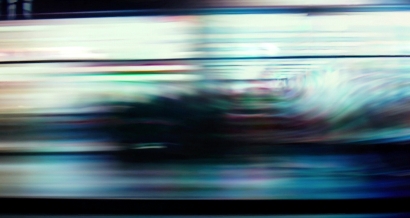
In The Tree of Life, following that door in the stony wilderness, the film presents the older son, played as a man by Sean Penn, dressed and in bed in a white room, with a female companion. Penn appears uncertain; and I am not sure what I think of Penn’s performance—he seems adrift (which could be a state of speculation and remembered grief; or a weak grasp of performance motivation). The house in which the older Jack apparently lives is a large, white structure, an abstract but more elegant, richer, version of his father’s home, the family home. The adult Jack recalls his brother, the middle brother, R.L., as “True. Kind. He died when he was 19.” In his large office building, Jack hears a voice say, “Find me.” The middle brother? The film becomes a work of memory, and a meditation on grief; a work of reclamation.
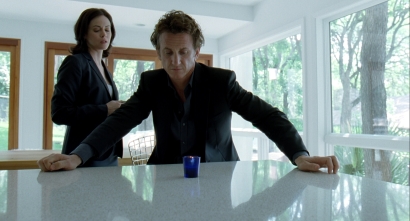
Sean Penn as the older Jack
The older brother Jack returns to years past, walking through the rooms where his parents are, their grief fresh. He sees them but they do not see him: it is a return through the imagination, through spiritual sympathy. It is a form of magical realism; and the kind of thing that literature and film, that art, can do well—make vivid the yearning and the gifts of the spirit. It is one of the first leaps of imagination, but far from the last; and soon the film director Malick introduces us to the origin of the universe. Its evolution is a matter of fact. Its imagery here is something that not many would dare. (I can think only of Stanley Kubrick, Steven Spielberg, Darren Aronofsky, and Tarsem Singh as filmmakers who would have the ambition, confidence, or skill.) That evolution begins with a gold shaft of light, then a smoky effusion, a burning explosion of energy, stars, vapors, expanding force, planets, a molten burning earth, eruptions of smoke, rushing waters, caves, cell division and mergers, the development of sea life and greenery, and early dinosaurs before the crash of a meteor into the earth and flooding. The film viewer witnesses the phenomena astounded, hardly knowing what to think. The question is, Did that evolution of the universe occur with divine purpose or independent of it? The mother believes in the divine, and petitions her god: “What are we to you? Answer me.” We see the heat of the earth, and its cooling; and hear her words, “We cry to you. My soul. My son. Hear us.” Is the call, the prayer, to a god who is present or absent?
Meanwhile, Jack thinks of the divine too: “You spoke to me through her. You spoke with me from the sky.” Growing up in a small town, close to nature, intimate with one’s own fears and hopes, fears and hopes that have few opportunities for address, in a culture that is very religious, in which religion is rigorously taught, and received with little if any opposition, it is almost impossible not to become a believer. The loneliness in a small town can make a child believe in anything—in angels or demons, in art or religion, in philosophy or science. Having presented the origin of the world, the filmmaker Terrence Malick gives us the origin of Jack: his parents’ romance, his mother’s pregnancy, the beginning of the family. A scene of a house underwater, featuring the son swimming up out of it, gives way to a scene of a baby’s birth. It is as if the son was somewhere else—in a parallel universe, a spiritual realm—waiting to be born into this one. Something similar occurs in Julie Dash’s great film Daughters of the Dust (1992), a story of southern life in which an African-American family prepares to move off its island home onto the mainland, with spiritual values set against material ambition, a story in which an unborn child is a subject of speculation for her parents—Is her mother’s husband the child’s father, or is a white rapist the child’s father? Will the child bring wife and husband together, or tear her parents apart?—and the unborn child, of whom we have ghostly glimpses, narrates much of Daughters of the Dust, narrates a story going on before she is born into the everyday world we see. In The Tree of Life, disparate family and childhood scenes are part of the drama of the film and create a backlog of memory, a form of consciousness, for the film viewer. The particularities of the individual mind are shared; and Jack’s spiritual arguments become part of our consideration. The period toys alone stir remembrance in the film, an elegy for a son and brother that reveals the entire family, the human family.
The mother has a loving, playful relation to her children; and the father is strict, exacting, demanding respect, issuing orders and reprimands. “Do you love your father?” the man asks his oldest son. “Yes, sir,” the boy answers. “Who do you love the most?” one of the boys asks his mother. “I love you all the same,” says the mother. (Such conversation can compel one to recall one’s own childhood, or that of others one has observed.) We see a scene of the mother floating in air, dancing in air. An angel? Is that what she is now in the adult Jack’s life, in heaven? Or how she has been thought of—very idealistically—by the boy he had been? These possibilities—strange, not entirely deciphered—give the film a rare dimension. Yet, while the mother is an easily loved presence, it is the father, the difficult father, whose character has great power, creative and destructive power. One is reminded that the word great used to mean more than it does now: we take it to mean pleasing or significant, but it once meant beautiful, large, mighty, original, terrifying.
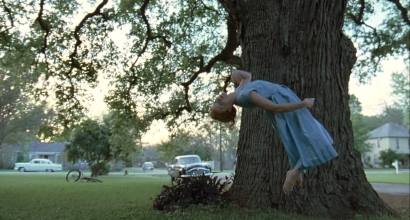
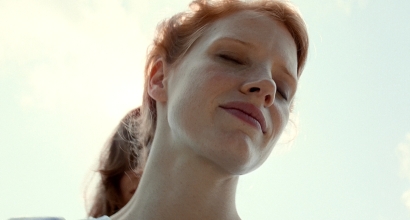
Jessica Chastain as the mother
The father, who had wanted first to be a great musician, then to be a great man in business, plays organ in the church and has his oldest son turn the pages of sheet music for him. We see the father playing in the family yard with his sons, spraying them with a water hose; and making one son close a house door quietly fifty times, until that delicacy becomes natural to the boy; teaching the three boys to box, though they are hesitant to hit their father; listening with pleasure to his second son’s playing guitar; and trying, at a large public pool, to revive a drowned boy. We hear the father telling his sons that their mother is naïve and does not understand the true nature of the world; and yet, we do not hear the mother articulate any of the father’s limitations. “You can’t be too good,” he tells his children. The wrong people go hungry, die, and get loved, the father tells his sons; and we soon see the white man and boys visit a black neighborhood for barbecue. There are not very many black people in the film, despite the American south’s volatile history: we see the hands of a black woman comforting the grieving mother, and someone else’s dark arms and hands moving over architectural plans in the older Jack’s office, and not much else; as if the faces and heads, the personalities and consciousness, of black people are too much, or not enough, for the film. Are African-Americans unknown or unknowable within the film’s terms? The absence of African-Americans in the presentation of southern life is usually suspect, as their labor is fundamental to that region and their history there so contentious, controversial, both in the past and in the present. It does say something, though not much, that the father goes to a black neighborhood for barbecue and has a respectful demeanor.
The father is an ambitious man of standards, who makes a show of friendliness, here glad-handing a business associate, and there being humorous with a restaurant waitress; and he is not a man who speaks easily of his sorrow. Seeing him kneel in church in prayer with a sadly thoughtful look on his face, after almost everyone else has gone, does convey that he has a dimension that has not been disclosed, something that is only between himself and his maker (and he kneels in prayer at home after he has learned that his middle son has died, his back to us—praying that his wife observes and refuses to interrupt, just as she does not interrupt when she sees and hears him playing piano, knowing he is her husband but also someone else): much of our world and each other remain mysterious; and film can suggest both that incomplete knowledge and what might be beyond our perception or comprehension. The boy Jack observes his father’s contradictions—his instructions and his manners, which sometimes violate those instructions: his father brags, insults people, and eats with his elbows on the table. Jack, seeing a drowning and a house fire, also asks questions about divinity; about fate, death, age, and god’s neglect or indifference. Jack sees the limitations of both fathers, the earthly and the divine. “Why should I be good if you aren’t?” asks Jack.
Both young Jack and the middle brother are inclined to rebel against their inventor-musician father; and all the sons celebrate when the father goes away on a business trip. “Why was he born?” Jack wonders of his father: a terrible question, but we next see the father playing music, the passion he betrayed by living a life of convention, by having regular work and a family. (In that way, images answer questions raised by words.) The father does not see how alienating his own behavior can be, how destructive: rather he accuses his wife of turning his children against him. The mother counsels love, appreciation, forgiveness; lessons that may allow her sons to go on loving their father. However, Jack does begin to feel murderous toward his father and resentful of his guitar-playing brother, who shares something, music, with their father. “Please God, kill him,” Jack thinks regarding his father; and Jack shoots his brother’s finger with a pellet gun, and then apologizes with a kiss. Father. Mother. Always you wrestle inside me. Jack, with other boys, breaks neighborhood windows; and he is fascinated by a woman neighbor and steals a piece of lingerie. His alienation from the fathers has led to disregard for their laws and that has led to moral transgression.
At the conclusion of The Tree of Life, the older Jack is a man in a desert, going through a door without an attached wall; a dream, or heaven. There are scenes of the planet, at its beginning or its end. Existences converge: both young Jack and old Jack are present in the barren landscape; and then there are others, family, strangers; reconciliation. There is an image of gold light within darkness, that opening and recurring image, the closing image, possibly an image of atoms or energy or a divine spark. For its beauty of images, attractive story, sympathy for human suffering, spiritual meditation, intellectual clarity, and satisfying construction, The Tree of Life deserves to be considered a great film.


